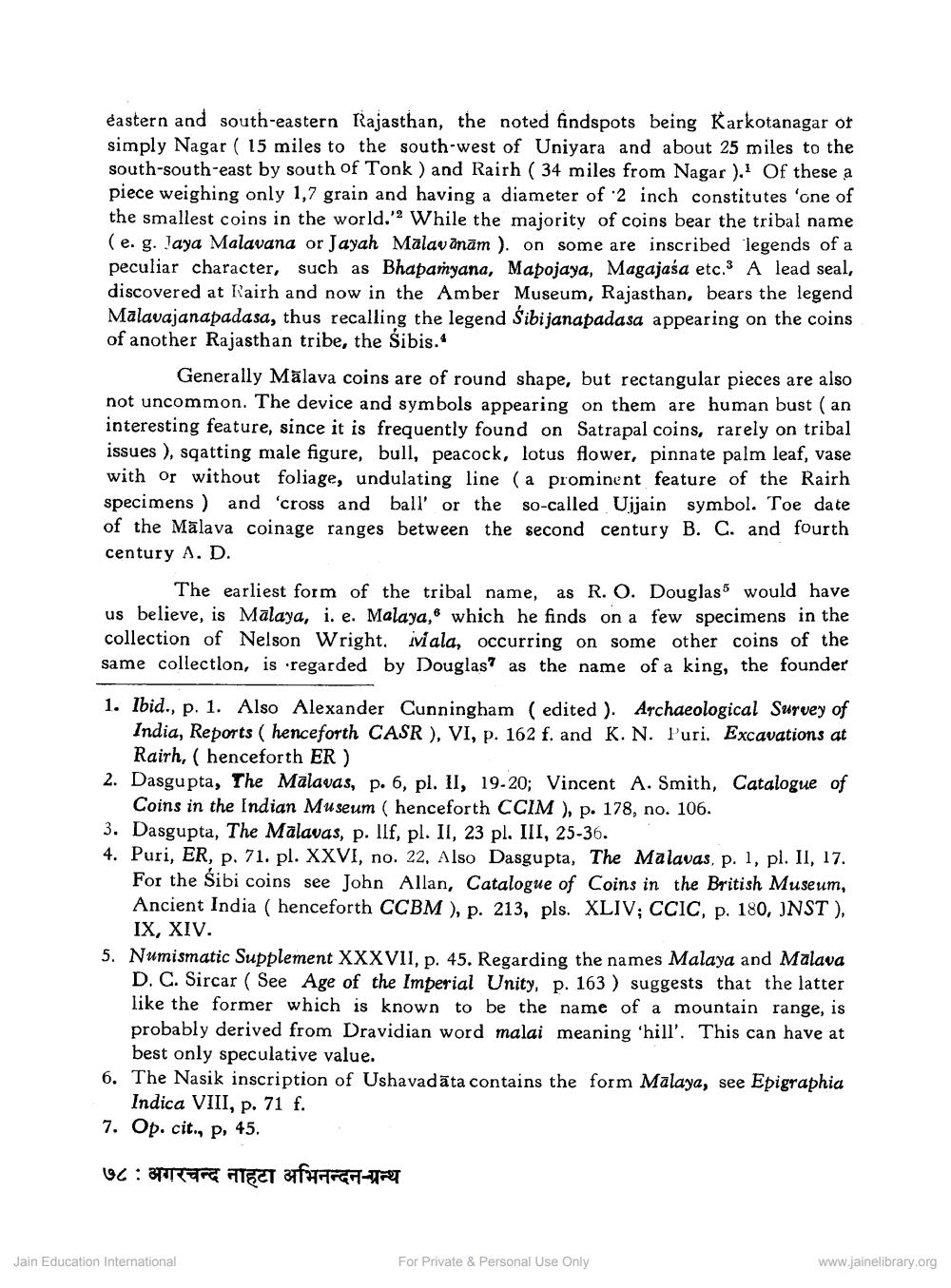________________
eastern and south-eastern Rajasthan, the noted findspots being Karkotanagar of simply Nagar (15 miles to the south-west of Uniyara and about 25 miles to the south-south-east by south of Tonk ) and Rairh (34 miles from Nagar). Of these a piece weighing only 1,7 grain and having a diameter of 2 inch constitutes 'one of the smallest coins in the world." While the majority of coins bear the tribal name (e. g. Jaya Malavana or Jayah Mālavānām). on some are inscribed legends of a peculiar character, such as Bhapamyana, Mapojaya, Magajaša etc. A lead seal, discovered at Kairh and now in the Amber Museum, Rajasthan, bears the legend Malavajanapadasa, thus recalling the legend Sibijanapadasa appearing on the coins of another Rajasthan tribe, the Šibis."
Generally Malava coins are of round shape, but rectangular pieces are also not uncommon. The device and symbols appearing on them are human bust (an interesting feature, since it is frequently found on Satrapal coins, rarely on tribal issues), sqatting male figure, bull, peacock, lotus flower, pinnate palm leaf, vase with or without foliage, undulating line (a prominent feature of the Rairh specimens) and 'cross and ball' or the so-called Ujjain symbol. Toe date of the Malava coinage ranges between the second century B. C. and fourth century A. D.
The earliest form of the tribal name, as R. O. Douglas would have us believe, is Malaya, i. e. Malaya," which he finds on a few specimens in the collection of Nelson Wright, iviala, occurring on iviala, occurring on some other coins of the same collectlon, is regarded by Douglas as the name of a king, the founder
1. Ibid., p. 1. Also Alexander Cunningham (edited). Archaeological Survey of India, Reports (henceforth CASR), VI, p. 162 f. and K. N. l'uri. Excavations at Rairh, (henceforth ER)
2. Dasgupta, The Malavas, p. 6, pl. 11, 19-20; Vincent A. Smith, Catalogue of Coins in the Indian Museum (henceforth CCIM ), p. 178, no. 106.
3. Dasgupta, The Malavas, p. Ilf, pl. II, 23 pl. III, 25-36.
4. Puri, ER, p. 71. pl. XXVI, no. 22, Also Dasgupta, The Malavas, p. 1, pl. II, 17. For the Sibi coins see John Allan, Catalogue of Coins in the British Museum, Ancient India (henceforth CCBM), p. 213, pls. XLIV; CCIC, p. 180, JNST), IX, XIV.
5. Numismatic Supplement XXXVII, p. 45. Regarding the names Malaya and Malava D. C. Sircar (See Age of the Imperial Unity, p. 163) suggests that the latter like the former which is known to be the name of a mountain range, is probably derived from Dravidian word malai meaning 'hill'. This can have at best only speculative value.
6. The Nasik inscription of Ushavadata contains the form Malaya, see Epigraphia Indica VIII, p. 71 f.
7. Op. cit., p. 45.
७८ : अगरचन्द नाहटा अभिनन्दन ग्रन्थ
Jain Education International
For Private & Personal Use Only
www.jainelibrary.org




